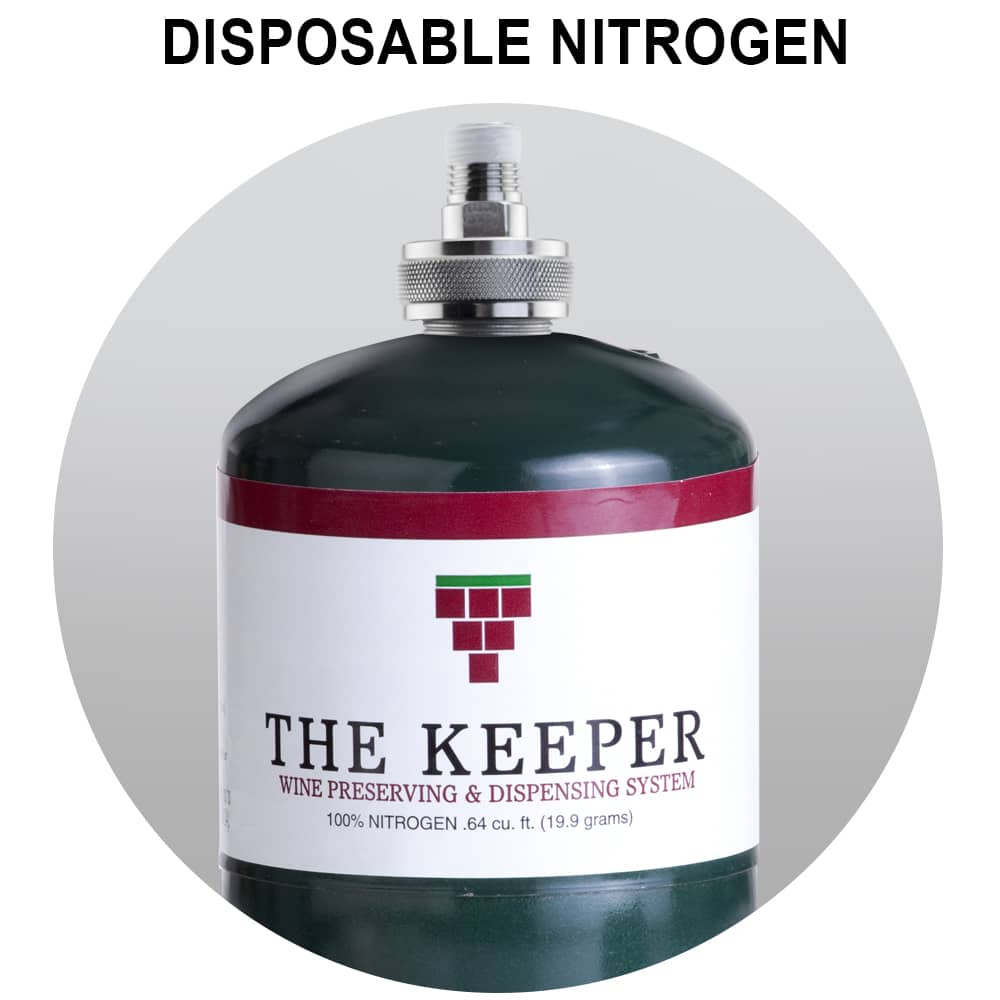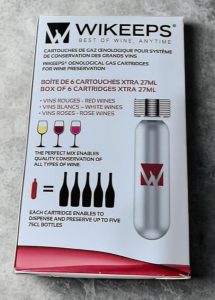Argon vs nitrogen wine preservation basics with CO₂
The physical properties of argon and nitrogen reveal why one typically works better for wine preservation. Argon, with its heavier density of 1.65 g/L, naturally forms a stable barrier above the wine’s surface, effectively minimizing oxidation. Nitrogen, weighing in at just 1.16 g/L, circulates through the container’s headspace and only provides protection after thoroughly purging the bottle of oxygen.
Why argon outperforms nitrogen in wine preservation
Argon offers superior preservation because its natural weight allows it to stay positioned over the wine, creating an oxygen barrier that nitrogen simply can’t match for extended periods. Real-world tests demonstrate that argon-treated bottles maintain quality for 1-4 weeks, while nitrogen-preserved wines typically show oxidation within just a few days.
- Density matters: With an atomic mass of 40 u, argon stays put over the wine, while lighter nitrogen (28 u) tends to dissipate into the air.
- Oxygen removal: Argon efficiently reduces oxygen levels below the critical 1% threshold required for preservation, whereas nitrogen requires more frequent application to achieve similar results.
- Bubble protection: Argon’s moderate solubility helps maintain dissolved carbon dioxide in semi-sparkling wines, preventing the flattening effect that can occur with nitrogen.
Important note: Neither gas can reverse existing oxidation – they only slow further deterioration. For optimal results, apply your wine preserver immediately after each pour. When planning to store an opened bottle for several days, argon’s superior weight typically preserves delicate fruit and floral characteristics more effectively.
How CO₂ blends support still and sparkling wines
Combining carbon dioxide with inert gases creates balanced wine preservation solutions. While pure argon might emphasize tannins, pure nitrogen could reduce bubbles, and pure CO₂ might inadvertently carbonate still wines. That’s why we recommend specialized gas mixtures – an 80% argon/20% CO₂ blend for still wines and an 80% nitrogen/20% CO₂ mix for sparkling varieties.
The argon/CO₂ combination provides excellent oxygen protection while adding subtle freshness – ideal for restaurants serving wine by the glass. For sparkling wines, the CO₂/N₂ mixture maintains proper carbonation levels; when stored at 10°C with a quality stopper, it can preserve about 500 mg/L of dissolved CO₂ for up to a week. Compare argon vs nitrogen for wine preservation — key differences and uses
Does argon keep wine fresh and for how long
Argon significantly outperforms vacuum pumps and nitrogen sprays in preserving opened bottles. Independent tests confirm that properly sealed, argon-treated bottles can maintain quality for 1-4 weeks depending on wine type, storage temperature, and how quickly you purge the headspace after pouring.
Coravin systems demonstrate argon’s effectiveness – the gas replaces poured wine to prevent oxygen ingress, allowing preservation for months. Our proprietary system delivers precise gas volumes through specialized stoppers, perfect for both busy service environments and long-term wine preservation.
For best results: purge the bottle’s headspace immediately after each pour, seal tightly, store upright in a cool place, and record the opening date. Remember these gases prevent future oxidation but can’t undo existing damage to the wine.
Choosing argon, nitrogen, and CO₂ for wine preservation
While argon is more expensive per liter, it forms a heavier protective layer in the bottle’s headspace. Nitrogen is more affordable and widely available but needs frequent replenishment during active service. The argon vs nitrogen wine cost decision depends on how long you keep bottles open and how often you access them. For resealed bottles stored for weeks, argon wine creates a lasting barrier that reduces gas consumption, while busy bars benefit from nitrogen’s cost-effectiveness for continuous purging and dispensing.
When to pick argon vs nitrogen by use case
Argon works best for wines stored longer than a week – particularly aromatic Pinot Noir or delicate aged whites where oxidation quickly diminishes complexity. Our 80% Ar / 20% CO₂ blends offer excellent preservation while maintaining a pleasant mouthfeel, making them perfect for premium wine programs. Nitrogen shines for short-term uses (hours to days) like transferring wine through hoses, purging tanks, or protecting headspace between pours in cost-conscious settings.
Smart establishments often combine both approaches: nitrogen for equipment and keg purging, supplemented by argon wine preserver cartridges for high-end by-the-glass service. For home users: vacuum pumps work for 48 hours, nitrogen sprays protect up to a week, while argon safeguards bottles for several weeks. Remember, proper sealing after gas application is crucial – the gas choice only matters with an airtight closure and correct storage. See how our 80% argon + 20% CO₂ blend enhances wine preservation for extended service.
Cost, consumption, and equipment trade-offs
Since argon is heavier than oxygen and air, it’s excellent for gentle tank purging and creates stable headspace protection in bottles, reducing gas needs for stored wine. Nitrogen systems consume gas with each fill cycle – economical for high-volume operations but less efficient for occasional use. Equipment also affects cost: most argon wine systems use simple spray cans or injectors, while nitrogen often requires pressurized tanks or cabinets that increase initial investment.
Our gas cartridges and dispensers let you choose based on preservation needs and budget. Sparkling wines benefit from our CO₂/N₂ Bubbl capsules that maintain fizz – pure nitrogen can strip bubbles while pure CO₂ may overcarbonate. Argon achieves <1% residual oxygen in headspace with lower flow than nitrogen-only purges – a key advantage in the argon vs nitrogen wine comparison. The systems work differently: argon performs best with minimal disturbance and tight seals, while nitrogen setups need pressure-rated components for continuous gas replacement.
| Factor | Argon | Nitrogen |
| Cost per liter | Higher | Lower |
| Density (g/L) | 1.65 (heavier than O₂) | 1.16 (lighter than air) |
| Protection duration | 1–4+ weeks | Days to ~1 week |
| Best use | Long-term bottle storage, premium pours | Bulk transfers, short service windows |
| Gas consumption | Lower for static storage | Higher, continuous replacement |
| Equipment | Spray cans, needle systems | Closed cabinets, pressurized tanks |
Argon and nitrogen taste impact and CO₂ balance
Do gases change wine taste or mouthfeel?
Both food-grade argon and nitrogen are completely neutral—they don’t add any odors or flavors to your wine while protecting its original color and aroma. However, slight differences in how these gases interact with wine can affect your tasting experience. Pure argon might make wines feel slightly more astringent, while nitrogen can reduce natural carbonation in lightly sparkling wines, potentially flattening their texture.
- Preserves original character : Neither gas alters the wine’s true flavor, aroma, or color when used correctly.
- Argon’s firming effect : Some tasters notice tighter tannins with pure argon—mixing in about 20% CO₂ helps soften wines without creating unwanted fizz.
- Nitrogen’s degassing : This gas can reduce natural CO₂ levels, affecting the mouthfeel of semi-sparkling styles like pét-nat.
- No reversing oxidation : Once oxygen has damaged aromas, no gas can fix it—prevention through quick inerting and proper sealing is key.
For balanced protection, we recommend an 80% argon/20% CO₂ blend that guards against oxidation while maintaining texture. Nitrogen/CO₂ mixes work better for preserving bubbles. Most reviews favor argon for long-term freshness, while nitrogen proves more cost-effective for quick turnover situations.
Choose gases based on your wine type and drinking timeline: delicate whites and aged reds benefit most from argon’s strong oxygen barrier, while everyday reds and high-volume service do well with nitrogen. Always apply gas gently, leave minimal headspace, seal tightly immediately after use, refrigerate upright bottles, and label opening dates to prevent spoilage.
Why Coravin uses argon instead of nitrogen
Coravin devices use 100% argon because this heavy gas creates a protective blanket over the wine without affecting its dissolved CO₂. Nitrogen would require constant flow or complete headspace purging to match argon’s protection—making it impractical for Coravin’s sampling-focused design.
This same principle guides our Wikeeps stoppers, which deliver precise doses of argon or gas blends. Our Linde-produced cartridges meet strict food-grade standards. While argon costs more per canister than nitrogen, its superior preservation makes it more economical for valuable collections—you’ll need fewer treatments per bottle over time.
Everyday tips for better wine preservation
Combine gas use with proper handling: always work cleanly, minimize air space, and store wine cool to slow oxidation and spoilage. After each pour, gently spray your chosen gas (argon or nitrogen), seal immediately, and store bottles upright in refrigeration.
Note that inert gases can’t restore lost bubbles in sparkling wines—use mechanical stoppers instead. Keep extra gas cartridges on hand, clean any equipment that touches wine, and ensure proper ventilation as these gases can displace breathable air. Learn more about gas selection, including purging techniques, headspace management, and cost considerations in our complete guide to wine preservation with argon vs nitrogen.


